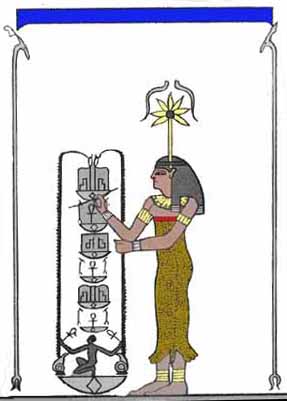

Seshat is the feminine consort/counterpart/wife/child of Thoth the Scribe, he who wrote the story/program of humanity's journey through "Time". She is a Magician, as is Isis, Thoth, Hermes, etc. Seshat bore the title 'Egyptian Fairy Godmother'. Her magic wand, with its seven pointed star, was the symbol which represented the source of all creative ideas, consciousness. Her powers of cause and effect for any affectation were legendary before the founding of Egypt.
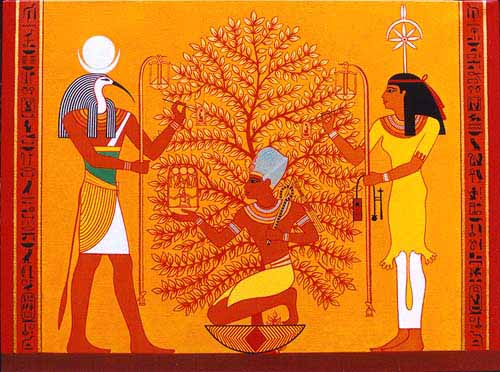
Seshat was the essence of cosmic intuition, creating the geometry of the heavens alongside Thoth. In Egyptian mythology, Seshat was originally the deification of the concept of wisdom, and so became a goddess of writing, astronomy, astrology, architecture, and mathematics.
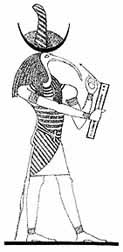

As reality is based on duality, one could consider Seshat the feminine aspect of Thoth. The Egyptians believed that she invented writing, while Thoth taught writing to mankind. She was known as 'Mistress of the House of Books', indicating that she also took care of Thoth's library of spells and scrolls. She is the patron of libraries and all forms of writing, including census and accounting work. Seshat was the only female that has been found (so far) actually writing. Other women have been found holding a scribe's writing brush and palette - showing that they could read and write, but these women were never shown in the act of writing itself. As goddess of writing, she was seen as a scribe, and record keeper, and her name itself means (she who) scrivens (i.e. she who is a scribe).
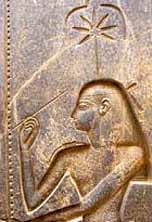
'The Female Scribe', 'Sesh" meaning scribe.
Like Thoth Sashet was an architect.

She wears a leopard skin dress.
The symbol over her head is a seven-pointed star or a rosette above
which is a pair of inverted cow's horns suggesting a crescent moon.
Her headdress was also her hieroglyph which may represent either a stylized flower or seven pointed star on a standing goddess that is beneath a set of down-turned horns. The horns may have originally been a crescent, linking Seshat to the moon and hence to her spouse, the moon god of writing and knowledge, Thoth. Safekh-Aubi (Sefekh-Aubi) is a title that came from Seshat's headdress, that may have become an aspect of Seshat or an actual goddess. Safekh-Aubi means 'She Who Wears the Two Horns' and relates to the horns that appear above Seshat's head.
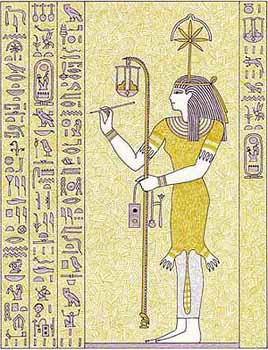
In art, she was depicted as a woman, with a stylized papyrus plant above her head, symbolizing writing, since the Egyptians wrote on a material derived from papyrus. The plant, her symbol, was shown having 6 spurs from the tip of the central stem, making it resemble a 7 pointed star. After the association with Thoth, who had originally been a moon god, the stylized papyrus was shown surmounted by a crescent moon, which, over time, degenerated into being shown as two horns arranged to form a crescent shape between them. When the crescent symbol had degenerated into the horns, she was sometimes known as Safekh-Aubi, meaning (she who) wears the two horns.
Usually, she is also shown holding a palm stem, carrying notches to denote the recording of the passage of time. She is frequently dressed in a leopard-skin, a symbol of funerary priests, because the pattern of the skin represents the stars, both a symbol of eternity, and associated with the moon.
From the Second Dynasty onwards, she helped ritualized laying of the foundations of temples and the ceremony known as the stretching of the cord (referring to the mason's line used to measure out the limits of the building). She was known as Mistress of the House of Architects. She was personal god of the king, aiding and assisting him. She was said to record all of his preceedings and his accomplishments.
As the divine measurer and scribe, she was believed to appear to assist the pharaoh in both these practices. It was she who recorded, by notching her palm, the time allotted to him by the gods for his stay on earth, and during the New Kingdom, she was involved in the pharaoh's jubilee festival - the Sed festival. She also assisted the pharaoh in the stretching the cord ritual, as well as recording the speeches the pharaoh made during crowning, and the inventory of foreign captives and goods gained in military campaigns.
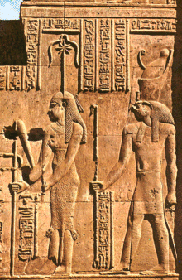
The Pyramid Texts reference Seshat as 'The Female Scribe' and 'The Lady of the House'. Nephthys is also referred to in the Pyramid Texts as 'Seshat, Foremost of Builders'. Some call Seshat the Egyptian goddess of the dead, daughter of Geb and Nut, sister of Isis, Osiris and Seth. According to one tradition, she was also the mother of Anubis by Osiris.
Her principal sanctuary was at Heliopolis. Along with Isis, she was one of the guardians of the corpse of Osiris. Depicted in human form wearing a crown in the form of the hieroglyph for house. Sometimes depicted as a kite guarding funeral bier of Osiris. No temple has ever been found in her name. But in a temple constructed during Hatshepsut's reign, queen Hatshepsut is shown directing Thoth to speak to Seshat to get the answers to his questions. On the Slab Stela of Prince Wep-em-nefret, from the Fourth Dynasty, he is mentioned as the 'Overseer of the Royal Scribes', 'Priest of Seshat'. Supposedly at a later time, the priesthood of Thoth took over the priesthood of Seshat.
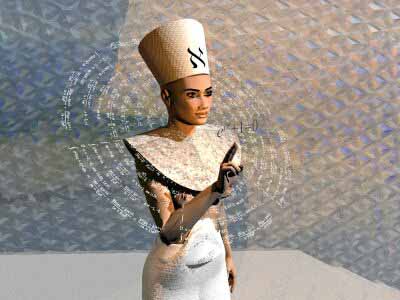
"Seshat, Great Lady of the House of Books, also known as Sefkhet-abwy, the Silicon Goddess, the Glass Cat and Our Lady of Mathematics. Among the Inner Sphere superintelligences there exist an archetypal attractor, Seshat, providing a shared interface to trans-singularity mathematical and notational understanding."